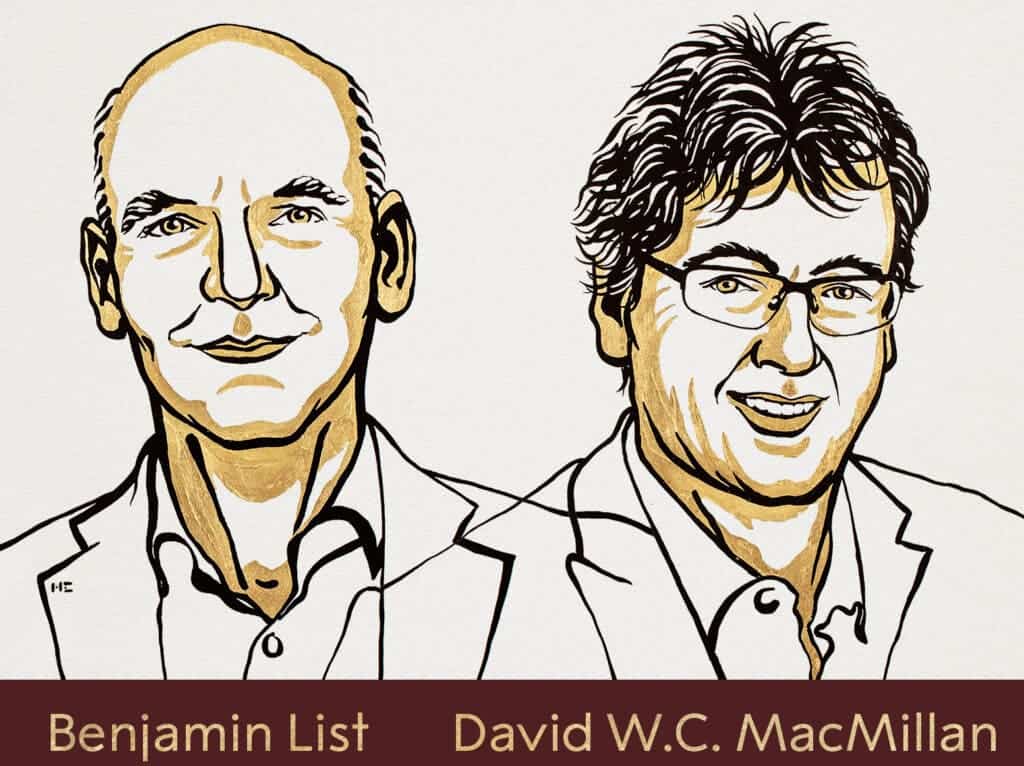Scottish-born David MacMillan and German Bernard List were awarded this year’s Nobel Prize in Chemistry for creating a new tool for molecular construction, organocatalysis, that has had a big impact on pharmaceutical research. It’s the third Nobel awarded so far this year after Medicine and Physics.

Many industries rely on chemists to build molecules that can form durable materials, store energy in batteries and stop the progression of diseases. This requires catalysts, substances that control and accelerate chemical reactions. Even our body has plenty of catalysts in the form of enzymes, shaping the many molecules that are needed for life.
Researchers used to think that there were only two types of catalysts, metals and enzymes. But List and Macmillan showed this wasn’t necessarily the case. Instead, they created a third type of catalysis known as asymmetric organocatalysis. It’s a “simple and ingenious concept”, Johan Åqvist of the Nobel Committee for Chemistry said.
Looking into the research
When researching catalytic antibodies, List started to think about how enzymes work. They are big molecules built from amino acids, with a significant proportion that also have metals that drive chemical processes. But many enzymes can catalyze chemical reactions without metals, driven instead by one or a few amino acids in the enzyme.
This is when List asked himself whether amino acids had to be part of an enzyme so to catalyze a chemical reaction or if a single amino acid could do the same job. He recalled previous research in the 1970s with an amino acid called proline was used as a catalyst. But he assumed this didn’t work well as he couldn’t find further studies.
Still, he tested if proline could catalyze an aldol reaction, in which carbon atoms from different molecules are linked together. It worked straight away. He proved proline is an efficient catalyst and that this amino acid can drive asymmetric catalysis. Proline is in fact a dream tool for chemists – simple, cheap, and environmentally friendly.
MacMillan realized that catalysts weren’t much used in industry and he assumed this was because sensitive metals were too difficult and expensive. He realized that he needed to rethink his whole approach and decided to stop looking at metals. Instead, he focused on designing simple organic molecules that could accommodate electrons.
He tested the molecules’ ability to drive a Diels-Alder reaction, used by chemists to build rings of carbon atoms. It worked perfectly. Some of the molecules were also very good at asymmetric catalysis. He then came up with the name organocatalysis to describe how chemical reactions could be catalyzed using small organic molecules.
A new concept for catalysis
List and Macmillan (alongside other researchers) went on to design many cheap and stable organocatalysts which can be used to drive many chemical reactions. These have led to more efficient molecular constructions, such as with the strychnine molecule. It first required 29 different chemical reactions but now it’s built-in just 12 steps thanks to organocatalysis.
This has also had a big impact on pharmaceutical research. Until chemists could do asymmetric catalysis, many pharmaceuticals contained both mirror images of a molecule. One was active, while the other could have unwanted effects. Now, thanks to organocatalysis, researchers can produce big volumes of asymmetric molecules much simpler.
“Benjamin List and David MacMillan remain leaders in the field, and have shown that organic catalysts can be used to drive multitudes of chemical reactions. Using these reactions, researchers can now more efficiently construct anything from new pharmaceuticals to molecules that can capture light in solar cells,” the Nobel academy wrote in a statement.
Previous winners in chemistry include Marie Curie and Fredick Sanger, who won twice. Last year’s winners were Emmanuelle Charpentier and Jennifer Dounda for creating genetic “scissors” that can edit DNA.









